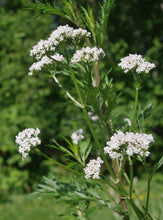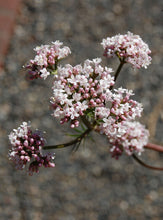Valerian is an herb of choice for many people when they need to calm down for a restful night’s sleep. Too concentrated a brew however, could have the opposite effect of creating rousing technicolour dreams!
There are many different varieties of valerian. One that grows in alpine meadows, with its thick, shallow, winding roots is quite different than the one usually grown in gardens that has a concentrated root system. All valerians, however, have roots with a very characteristic smell, an odour that some people love and others can’t stomach. The flower scent is very different: quite fragrant and heady.
The stems of valerian are hollow and grooved. The fernlike leaves are deeply divided and become progressively smaller on the flower stalks. The tiny flowers are white or pinkish, are arranged in flat clusters and start blooming in late May. Plants sometimes grow to over 6 feet.
The value of valerian as an anti-spasmodic and sleep aid is well known but it is not often touted as an easy and valuable plant for the home gardener. It’s a very safe herbal tranquilizer and doesn’t have narcotic aftereffects. It can be grown in full sun or partial shade. It tolerates a wide range of soils although it prefers a moist, but well-drained loam.
Valerian can be direct sown outdoors in early spring, or started indoors 4 weeks prior to transplanting in late spring. Small seeds can be tamped into the soil or covered with a thin layer of soil. They should germinate within 7-14 days.
The roots are usually harvested in the fall of the second or third year. After removing dirt from the intertwining rootlets, cut them in small pieces and then dry them out of direct sun for about a week.
When brewing valerian for tea, it’s best to experiment to see what dose works best for you. A general recommendation is to gently simmer a small handful of dried root in two cups of water for about 10 minutes. That way you can share the brew or reheat it for another night.




